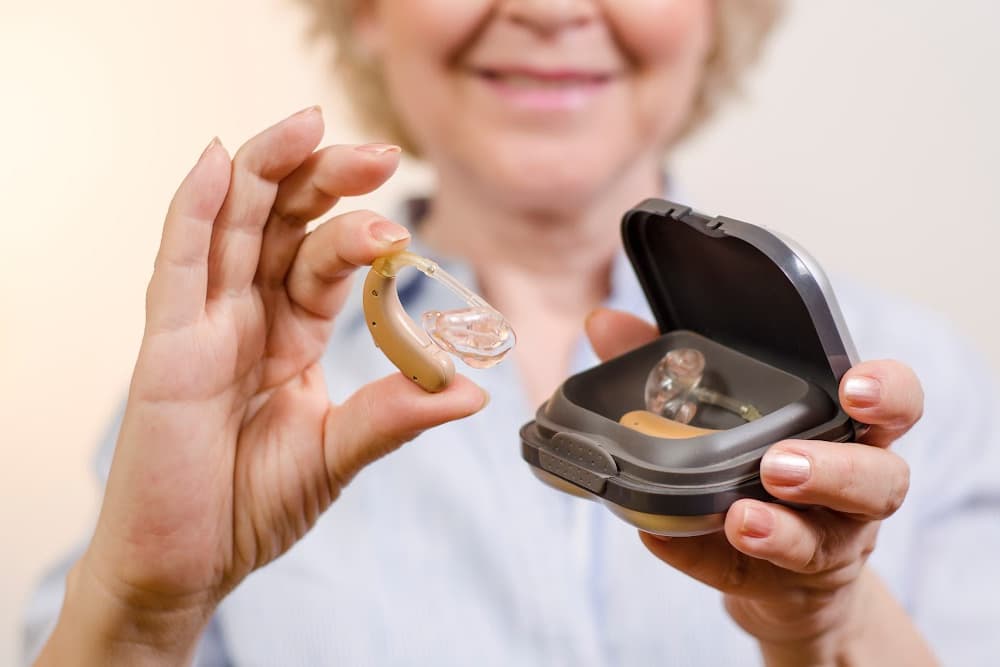Selecting the right hearing aid can be an overwhelming task, especially with the huge range of options available today. Whether you’re considering a basic model or an advanced device with the latest technology, understanding the key features that match your unique needs is essential for making the right choice to fit your lifestyle. In this guide, we’ll explore the most important aspects to consider when choosing a hearing aid, ensuring that you find a device that perfectly fits your lifestyle and hearing requirements.

Understanding Hearing Aid Styles
The first major decision in selecting a hearing aid is choosing the style that best suits your needs. Hearing aids come in a variety of designs, each offering distinct advantages based on your level of hearing loss, comfort preferences, and aesthetic desires. Understanding the pros and cons of each style is critical to making the right choice.
Behind-the-Ear (BTE) Models: Durability and Power
Behind-the-Ear (BTE) Models are known for their durability and ease of use. BTE hearing aids rest comfortably behind the ear and are typically connected to an earpiece inside the ear canal. They are a popular choice for individuals with severe hearing loss due to their powerful amplification capabilities and ease of handling. BTE models are often larger, making them easier to handle, especially for those with dexterity issues. Additionally, BTE models are less susceptible to earwax and moisture buildup, which can prolong their lifespan and reduce the need for frequent repairs.
However, their larger size may be a drawback for those who prefer a more discreet option. Some users may find BTE hearing aids less aesthetically pleasing, as they are more visible than other styles. Despite this, many modern BTE models are designed to be sleek and stylish, with various colors available to blend with hair or skin tone.
In-the-Ear (ITE) and In-the-Canal (ITC) Models: Discreet and Comfortable
In-the-Ear (ITE) and In-the-Canal (ITC) Models are designed for those who prioritize discretion. These hearing aids are custom-fitted to the inside of your ear, making them less noticeable to others. ITE and ITC models are ideal for those with mild to moderate hearing loss who prefer a less noticeable device. Despite their smaller size, many of these models come equipped with advanced features, making them a versatile option for those who want both performance and subtlety.
ITE models fill the outer portion of the ear and are slightly more visible than ITC models, which fit partially or completely inside the ear canal. The deeper placement of ITC models offers even greater discretion but may require more frequent cleaning due to earwax buildup. Both styles provide a comfortable fit, but their compact size can make them challenging for individuals with dexterity issues to handle and adjust.
Completely-in-Canal (CIC) and Invisible-in-Canal (IIC) Models: Nearly Invisible
For those who desire the utmost discretion, Completely-in-Canal (CIC) and Invisible-in-Canal (IIC) models are excellent options. These hearing aids are custom-molded to fit deep within the ear canal, making them nearly invisible to others. CIC and IIC models are typically recommended for individuals with mild to moderate hearing loss.
The primary advantage of CIC and IIC models is their minimal visibility. However, due to their small size, they may lack some of the advanced features found in larger models, such as directional microphones or wireless connectivity. Additionally, their deep placement within the ear canal can make them more susceptible to earwax buildup and moisture, requiring diligent maintenance and cleaning.

Key Features to Look for in a Hearing Aid
Once you’ve chosen the style that best suits your needs, it’s important to consider the features that will enhance your hearing experience. The right features can significantly impact the performance of your hearing aid and your overall satisfaction with the device. Here are some of the most crucial features to look for when selecting a hearing aid.
Directional Microphones: Clarity in Noisy Environments
If you often find yourself in noisy environments, directional microphones are a must-have feature. Directional microphones focus on sounds coming from in front of you while reducing background noise from other directions. This enhances speech understanding, making it easier to engage in conversations, even in crowded or noisy settings.
For instance, if you’re dining at a busy restaurant or attending a social gathering, directional microphones help you concentrate on the conversation in front of you, rather than being overwhelmed by the surrounding noise. This feature is particularly beneficial for those who lead an active social life or work in environments with significant background noise.
Noise Reduction: Enhanced Listening Comfort
Modern hearing aids are equipped with sophisticated noise reduction algorithms that help filter out unwanted ambient sounds. This feature works hand-in-hand with directional microphones to sharpen your focus on specific sounds, such as a conversation in a busy restaurant, allowing you to enjoy social interactions without distraction.
Noise reduction technology is especially useful in environments where consistent background noise, such as the hum of air conditioning or traffic, can be distracting. By reducing these ambient sounds, noise reduction enhances your overall listening comfort and reduces the cognitive effort required to understand speech in noisy settings.
Wireless Connectivity: Seamless Integration with Modern Technology
With the rise of smart technology, many hearing aids now offer wireless connectivity. This feature allows you to stream audio directly from your smartphone, television, or other devices, providing a seamless listening experience. Wireless connectivity eliminates the need for additional accessories, ensuring that you can enjoy clear and direct sound no matter where you are.
For example, with Bluetooth-enabled hearing aids, you can take phone calls, listen to music, or watch TV with audio streamed directly to your hearing aids. This not only improves sound quality but also allows for hands-free operation, making your hearing aids an integral part of your daily technology ecosystem.
Rechargeable Batteries: Convenience and Cost Savings
The hassle of constantly replacing tiny batteries is a thing of the past with the introduction of rechargeable hearing aids. Rechargeable batteries offer both convenience and cost savings, making them an attractive option for those who want to minimize the maintenance of their hearing aids.
Rechargeable hearing aids typically come with a charging dock, allowing you to recharge the batteries overnight. This eliminates the need to carry spare batteries and reduces the environmental impact associated with disposable batteries. For individuals with dexterity issues, rechargeable hearing aids are also easier to manage, as there’s no need to handle small batteries.

Customization and Comfort: Ensuring a Perfect Fit
Comfort is just as important as functionality when it comes to hearing aids. A device that fits well and feels comfortable is essential for daily wear. Comfort can vary depending on the fit, weight, and size of the hearing aid, so it’s important to try out different models and consult with your audiologist to find the best option for you.
Custom Earmolds: Tailored Fit for Enhanced Comfort
Many hearing aid styles offer the option of custom earmolds, which are tailored to the unique shape of your ear. Custom earmolds provide a snug fit, enhancing both comfort and sound quality. They are particularly beneficial for those with unusual ear shapes or those who experience discomfort with standard hearing aid designs.
Custom earmolds can also improve the retention of the hearing aid, preventing it from slipping or moving out of place during daily activities. Additionally, they can help reduce feedback and whistling, ensuring a clear and consistent sound experience.
Balancing Aesthetics and Performance
When choosing a hearing aid, it’s essential to strike a balance between aesthetics and performance. While it’s natural to want a discreet device, it’s equally important to ensure that your hearing aid has the necessary features and power to meet your hearing needs. Working closely with your audiologist can help you find a hearing aid that offers both the performance and appearance you desire.
Maximizing the Longevity of Your Hearing Aid
To get the most out of your hearing aid, regular maintenance and adjustments are essential. As your hearing needs change over time, your hearing aid may require fine-tuning to ensure optimal performance. Regular check-ups with your audiologist can help you stay on top of any necessary adjustments, allowing you to continue enjoying clear and comfortable hearing.
Regular Maintenance: Keeping Your Hearing Aid in Top Condition
To ensure your hearing aid continues to perform at its best, it’s important to follow a regular maintenance routine. This includes cleaning the device, replacing filters, and storing it properly when not in use. Proper maintenance can extend the lifespan of your hearing aid and prevent issues such as feedback, reduced sound quality, and battery drain.
For instance, daily cleaning with a soft, dry cloth can help remove earwax and debris from your hearing aid. It’s also important to keep the hearing aid dry, as moisture can damage the electronic components. Using a dehumidifier specifically designed for hearing aids can help remove moisture and keep your device in optimal condition.
Adjustments and Fine-Tuning: Adapting to Changing Hearing Needs
As you use your hearing aid, you may find that your hearing needs change over time. Regular check-ups with your audiologist are crucial for ensuring that your hearing aid is properly adjusted to meet these changing needs. Your audiologist can make fine-tuning adjustments to the device’s settings, such as amplification levels, to ensure that you continue to experience clear and comfortable hearing.

Selecting the ideal hearing aid is a highly personal process that involves thoughtful consideration of various styles, features, and your unique hearing needs. With so many options available, it’s essential to take the time to explore what each type offers and how it aligns with your lifestyle. This journey is not just about finding a device that improves your hearing but also about discovering a solution that enhances your daily experiences and fits comfortably into your life.
Working closely with your audiologist is a crucial step in this process. Their expertise can guide you through the selection of a hearing device that not only meets your specific hearing requirements but also complements your personal preferences. Whether it’s choosing the right style, understanding the technological features, or ensuring a perfect fit, your audiologist can help you navigate these decisions with confidence. Together, you can find a hearing aid that brings clarity to your world and contributes positively to your overall well-being.
Ultimately, the right hearing aid can have a profound impact on your quality of life, allowing you to stay connected to the people and experiences that are most important to you. This guide has provided a comprehensive overview to help you make an informed choice, but remember that the support of a knowledgeable audiologist can make this journey both seamless and rewarding. With the right information and professional guidance, you can find the perfect hearing aid that not only enhances your hearing but also enriches your everyday life.





